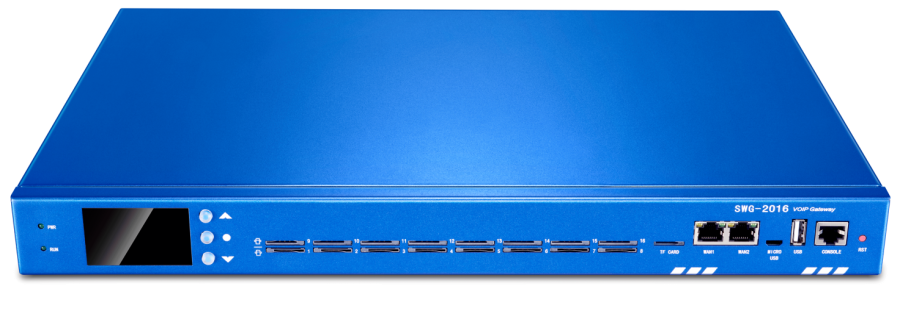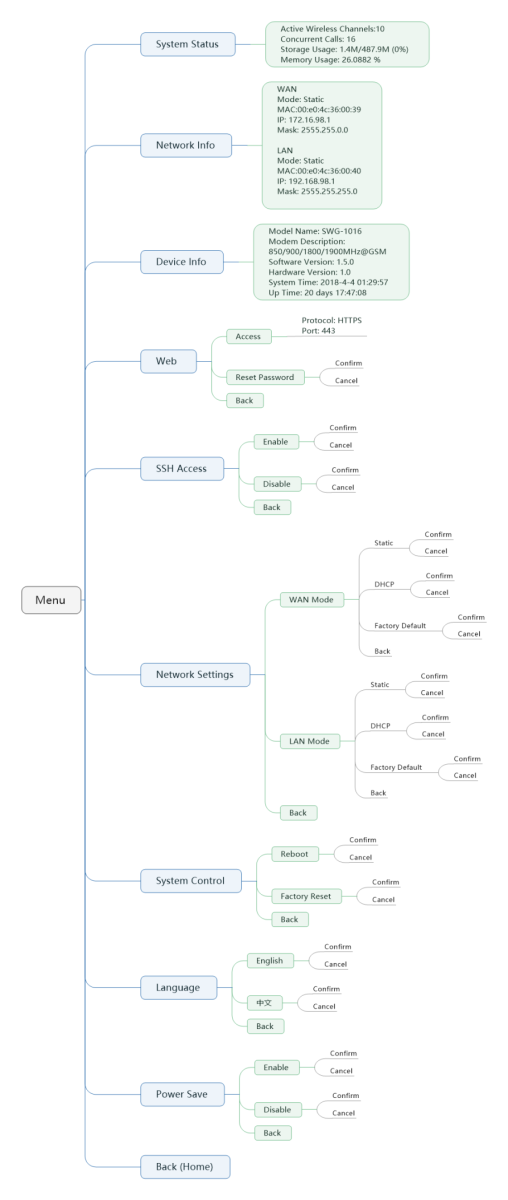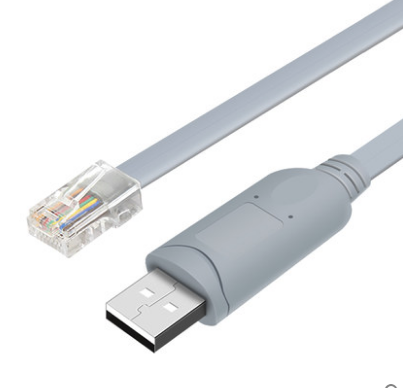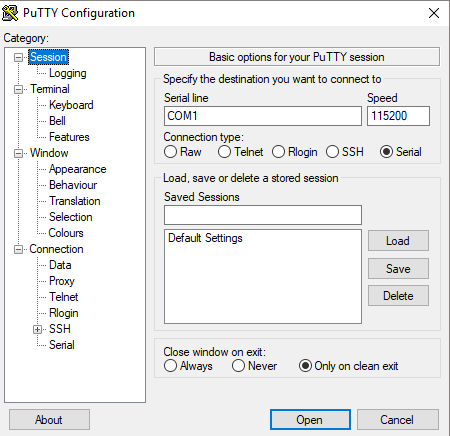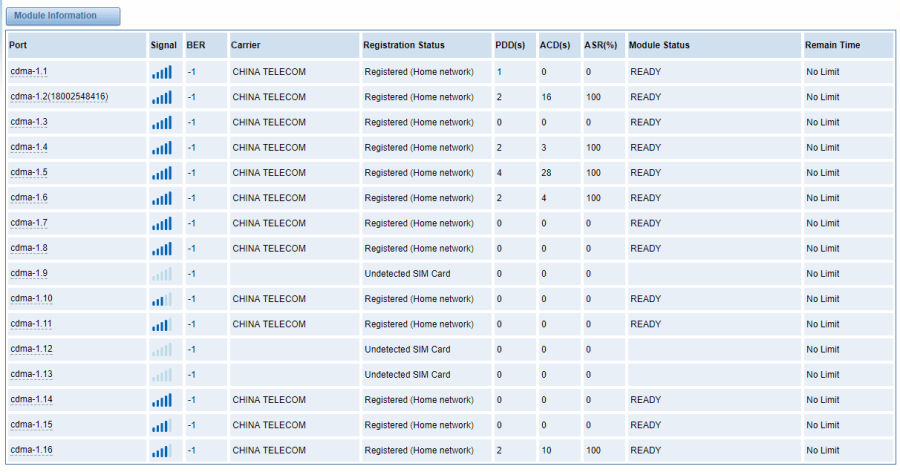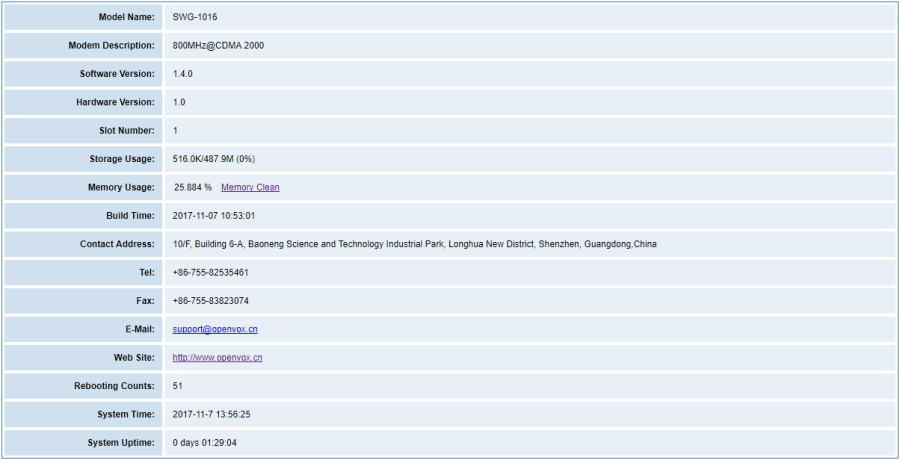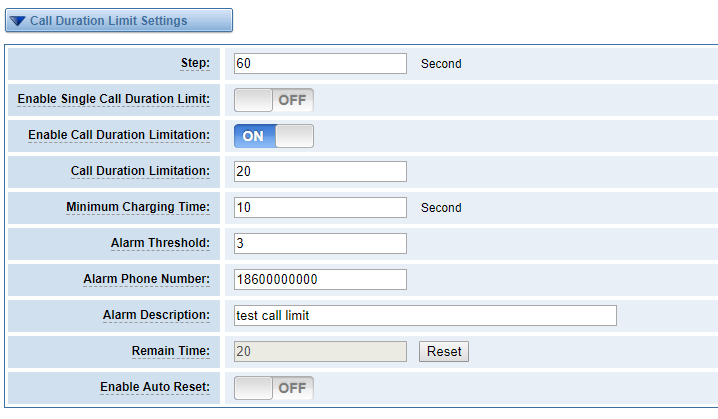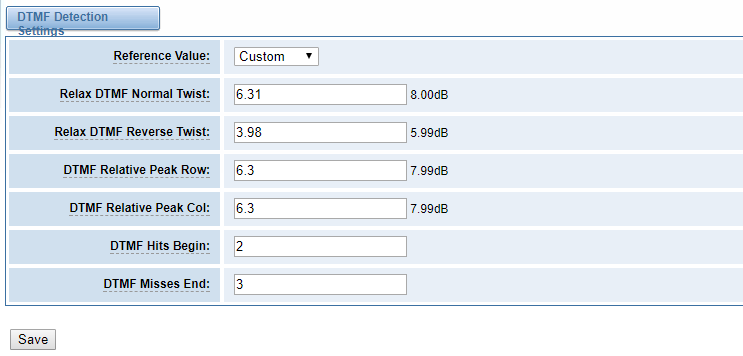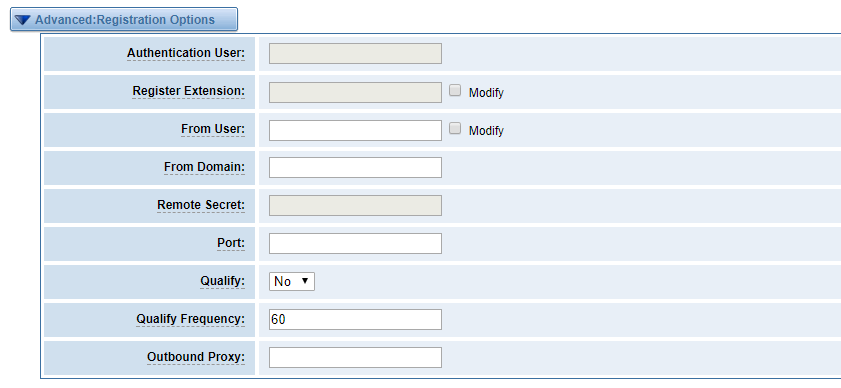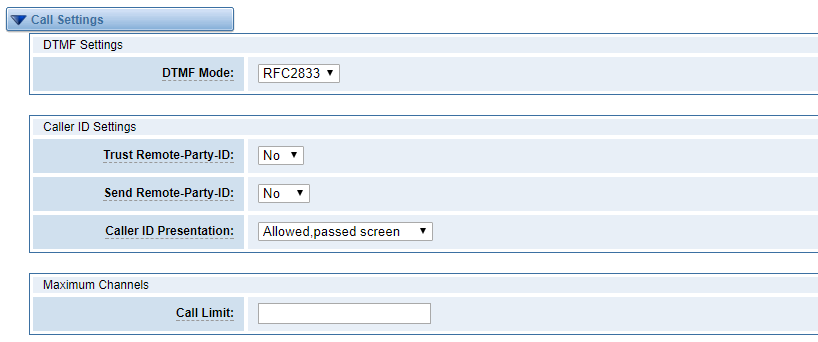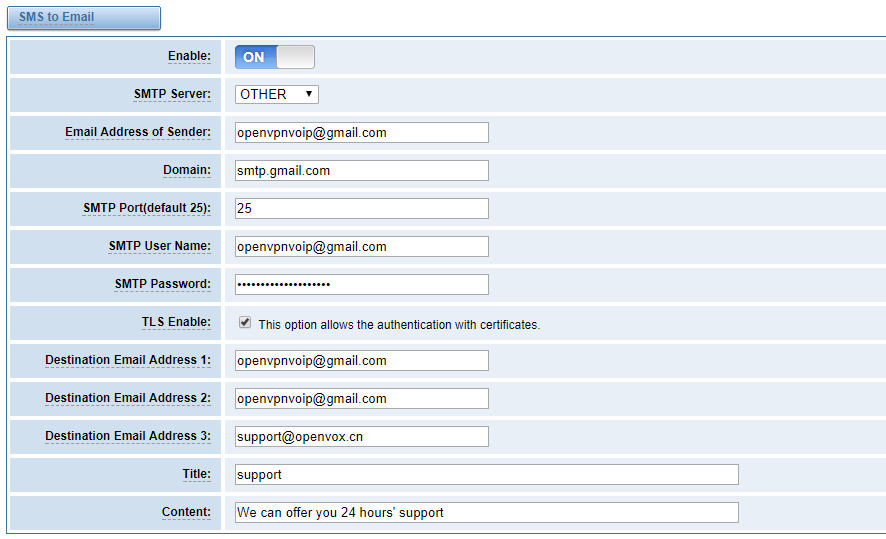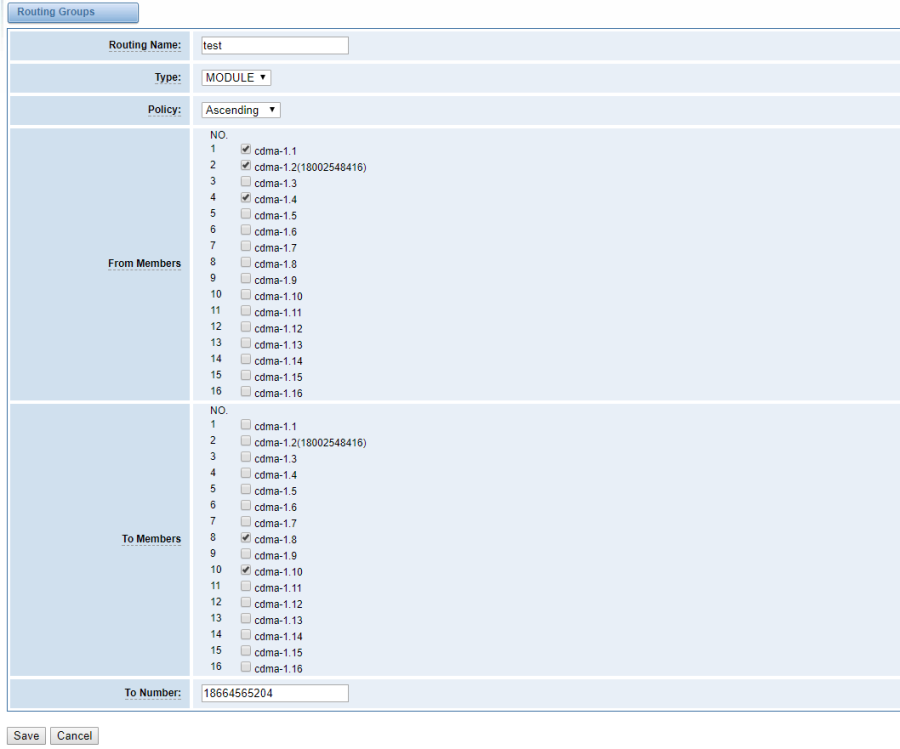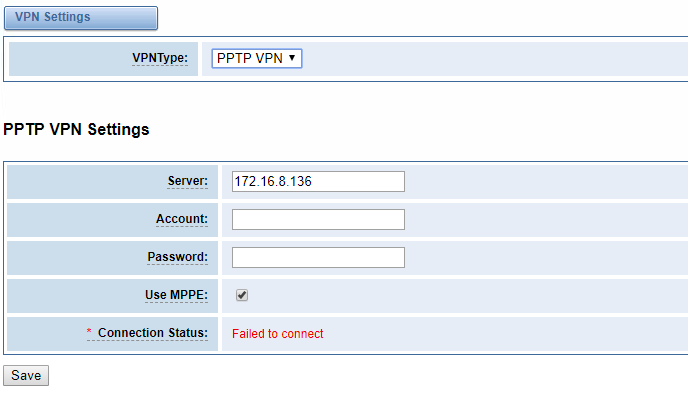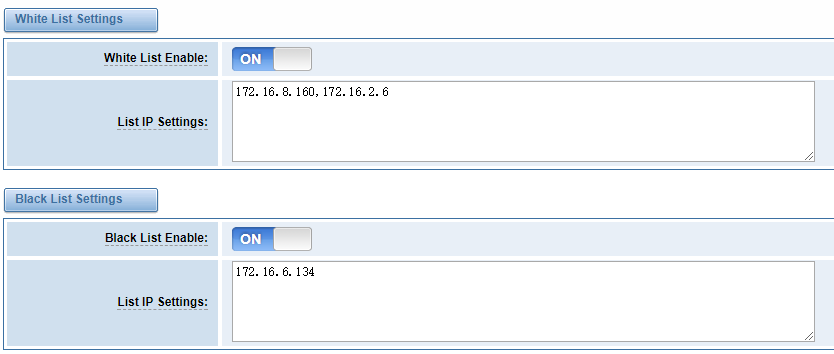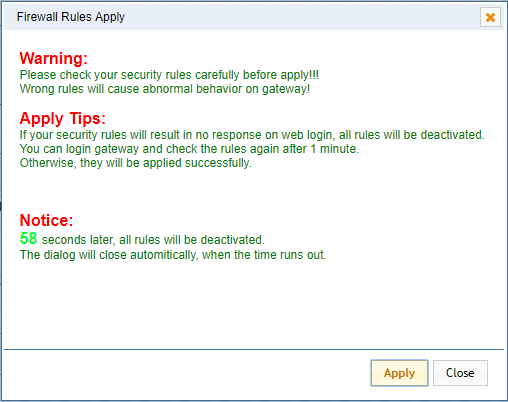OpenVox Communication Co Ltd
...
Disclaimer
OpenVox Inc. reserves the right to modify the design, characteristics, and products at any time without notification or obligation and shall not be held liable for any error or damage of any kind resulting from the use of this document.
OpenVox has made every effort to ensure that the information contained in this document is accurate and complete; however, the contents of this document are subject to revision without notice. Please contact OpenVox to ensure you have the latest version of this document.
Trademarks
All other trademarks mentioned in this document are the property of their respective owners.
Revise History
...
Version
...
Release Date
...
Description
...
1.0
...
10/5/2018
...
Full text
Contents
toc
OpenVox Communication Co Ltd
SWG-20XX Gateway User Manual
Version 1.0
OpenVox Communication Co Ltd
Address:10/F, Building 6-A, Baoneng Science and Technology Industrial Park, Longhua New District, Shenzhen, Guangdong,China 518109
Tel: +86-755-66630978, 82535461, 82535362
Business Contact:
| Anchor | ||||
|---|---|---|---|---|
|
| Anchor | ||||
|---|---|---|---|---|
|
Technical Support: support@openvox.cn
Business Hours: 09:00-18:00(GMT+8) from Monday to Friday
URL: www.openvox.cn
Thank You for Choosing OpenVox Products!
Confidentiality
Information contained herein is of a highly sensitive nature and is confidential and proprietary to OpenVox Inc. No part may be distributed, reproduced or disclosed orally or in written form to any party other than the direct recipients without the express written consent of OpenVox Inc.
Disclaimer
OpenVox Inc. reserves the right to modify the design, characteristics, and products at any time without notification or obligation and shall not be held liable for any error or damage of any kind resulting from the use of this document.
OpenVox has made every effort to ensure that the information contained in this document is accurate and complete; however, the contents of this document are subject to revision without notice. Please contact OpenVox to ensure you have the latest version of this document.
Trademarks
All other trademarks mentioned in this document are the property of their respective owners.
Revise History
Version | Release Date | Description |
1.0 | 10/5/2018 | Full text |
Contents
1. Overview
1.1 What is SWG-20XX?
1.2 Product Introduction
1.3 Application
1.3.1 LCD And Buttons
1.3.2 Multifunction button
1.3.3 Console
1.4 Main Features
1.5 Physical Information
1.6 Software
2. System
2.1 Status
2.2 Time
2.3 Login Settings
2.4 General
2.4.1 Language Settings
2.4.2 Scheduled Reboot
2.5 Tools and Information
2.5.1 Reboot Tools
2.5.2 Update Firmware
2.5.3 Upload and Backup Configuration
2.5.4 Restore Configuration
2.6 Information
3. MODULE
3.1 MODULE Settings
3.1.1 Call Duration Limit Settings
3.2 DTMF
3.3 Toolkit
4. VOIP
4.1 VOIP Endpoints
4.1.1 Add New SIP Endpoint
4.1.2 Add New IAX2 Endpoint
4.2 Batch SIP Endpoints
4.3 Advanced SIP Settings
4.3.1 Networking
4.3.2 Paesing and Compatibility
4.3.3 Security
4.3.4 Media
4.3.5 Codec Settings
4.4 Advanced IAX2 Settings
4.4.1 General Settings
4.4.2 Music on Hold
4.4.3 Instruction of Codec Settings
4.4.4 Jitter Buffer Settings
4.4.5 Misc Settings
4.4.6 Quality of Service
5. Routing
5.1 Groups
5.2 Batch Creating rules
5.3 MNP Settings
6. SMS
6.1 General
6.1.1 Sender Options
6.1.2 SMS to Email
6.1.3 SMS Control
6.1.4 HTTP to SMS
6.1.5 SMS to HTTP
6.2 SMS Sender
6.3 SMS Inbox
6.4 SMS Outbox
6.5 SMS Forwarding
7. Network
7.1 LAN Settings
7.2 WAN Settings
7.3 VPN Settings
7.4 DDNS Settings
7.5 Toolkit
7.5.1 Ping and Traceroute
7.5.2 TCP Capture
7.6 Security Settings
7.6.1 Firewall Settings
7.6.2 White/Black List Settings
7.7 Security Rules
7.8 SIP Capture
8. Advances
8.1 Asterisk API
8.2 Asterisk CLI
8.3 Asterisk File Editor
8.3 Cloud Management
9. Logs
Appendix Feature List
General Info
VOIP Characters
Network
System Features
Management
| Anchor | ||||
|---|---|---|---|---|
|
| Anchor | ||||
|---|---|---|---|---|
|
| Anchor | ||||
|---|---|---|---|---|
|
| Anchor | ||||
|---|---|---|---|---|
|
...
20XX?
OpenVox SWG-30XX 20XX series gateways include SWG-30162016 G/C/L and SWG-30322032 G/C/L. SWG-30XX 20XX series gateways supports multiple codecs,including G.711U, G.711A, GSM, G.722, G.723, G.726, G.729 multiple coding. Our products support SMS messages sending, receiving, group sending and SMS to E-mail. The SWG-30XX 20XX series gateways will be 100% compatible with Asterisk, 3CX, FreePBX,FreeSWITCH SIP server and VOS VoIP operating platform.It can help users reduce telecommunications and communication costs.Anchor _GoBack _GoBack
| Anchor | ||||
|---|---|---|---|---|
|
The SWG-30XX 20XX series gateways are available in a variety of models, and each model supports a different number of ports and frequency bands. The following table shows:
Model | Module | Ports | Network Interface | Band | USB | TF | Console |
SWG-3016C2016C | CDMA | 16 | 2 | 800MHz@CDMA 2000 | 1 | 1 | 1 |
SWG-3016G2016G | GSM | 16 | 2 | 850/900/1800/1900MHz@GSM | 1 | 1 | 1 |
SWG-3016L2016L | LTE | 16 | 2 | LTE FDD: B1/B3/B5/B8 | 1 | 1 | 1 |
SWG-3032C2032C | CDMA | 32 | 2 | 800MHz@CDMA 2000 | 1 | 1 | 1 |
SWG-3032G2032G | GSM | 32 | 2 | 850/900/1800/1900MHz@GSM | 1 | 1 | 1 |
SWG-3032L2032L | LTE | 32 | 2 | LTE FDD: B1/B3/B5/B8 | 1 | 1 | 1 |
| Anchor | ||||
|---|---|---|---|---|
|
| Anchor | ||||
|---|---|---|---|---|
|
| Anchor | ||||
|---|---|---|---|---|
|
LED Indicator/Icon/Buttons | Color/ IconStaus/ Icon | Staus |
Display Icon | Module Initiating,Disable | |
No SIM Card | ||
Searching for Signal | ||
One grid Signal | ||
Two grid Signal | ||
Three grid Signal | ||
four grid Signal | ||
fives grid Signal | ||
Worst Signal Quality During a Call | ||
Medium Signal Quality During a Call | ||
Best Signal Quality During a Call | ||
Network Status LED | Green and Flash | Network Connected |
Power LED | Always Green | Power on |
| Alarm LED | LED is off | System runs normally |
| Port LED | LED is off | No sim card inserted or port is unavailable |
| Green and Flash | Sim card is in use | |
| Always Green | Port is available | OFF | Power down |
ON | Power on | |
RST Button | – | Press and hold the RST button for 3-5 seconds. The display jumps to the "System Booting" page to restart the system. |
...
PER Button | OFF | Power down |
ON | Power on | |
RST Button | – | Press and hold the RST button for 3-5 seconds. The display jumps to the "System Booting" page to restart the system. |
| Anchor | ||||
|---|---|---|---|---|
|
| Anchor | ||||
|---|---|---|---|---|
|
- [▲] : Press this key to flip up
- OK :
Press this key in the signal interface - enter the menu
Press this key in the menu interface – Confrim
Press this key if it is Non-signal interface and there is no return option in the current interface - Back
3. [▼] : Press this key to flip down
4. Press any key in the signal interface to enter the menu interface.
5. If no button is operated within 20S, return to the main interface.
The main factions are as follows:
...
To ensure easy maintenance, SWG-30XX 20XX series gateway devices provide a serial port with a baud rate of 115200 bps. Users can connect to the computer through RJ45 to USB cable for maintenance related configuration.
Login device:
Step 1: Prepare the following serial cable (baud rate: 115200bps)
Step 2: Connect the USB port of the serial cable to the PC; connect the RJ45 port to the console port of the device.
Step 3: Configure the login software
After the above configuration, click "Open" to enter the device's background page. Use the same login name and password as SSH to enter the system.
| Anchor | ||||
|---|---|---|---|---|
|
- Based on Asterisk®
- Wide selection of codecs and signaling protocol
- Support SMS sending, receiving, group sending
- Support transferring SMS to E-mail
- Support SMS remotely controlling gateway
- Support USSD service
- Support PIN identification
- Support unlimited routing rules and flexible routing settings
- SIM cards are all hot-swap
- Stable performance, flexible dialing, friendly GUI
| Anchor | ||||
|---|---|---|---|---|
|
| Anchor | ||||
|---|---|---|---|---|
|
- Size(No antenna and hanging ears): 440mm*44mm*300mm
- LCD dimension:2.4"
- LCD resolution ratio: 240*400
- LAN port:1
- WAN port:1
- USB Interface:1
- TF Infterface:1
- SIM Cards: hot-swap
- Operation Temperature: 0~40°C
- Storage Temperature: -20~70°C
- Operation humidity:10% ~ 90% non-condensing
| Anchor | ||||
|---|---|---|---|---|
|
| Anchor | ||||
|---|---|---|---|---|
|
- Default IP:172.16.98.1
- Username:admin
- Passward:admin
For first time, you can access SWG-1016C using default IP 172.16.98.1. Then configure the module as you want.
...
On the "Status" page, you will find all Modules, SIP, IAX2, Routing and Network information.
Figure 2-1 Systm Status
Table 2-1 Description of System Status
Options | Definition |
Port | Number of each ports. |
Signal | Display the signal strength of in each channels of gateway. |
BER | Bit Error Rate. |
Carrier | Display the network carrier of current SIM card. |
Registration Status | Indicates the registration status of current module. |
PDD | Post Dial Delay (PDD) is experienced by the originating customer as the time from the sending of the final dialed digit to the point at which they hear ring tone or other in-band information.Where the originating network is required to play an announcement before completing the call then this definition of PDD excludes the duration of such announcements. |
ACD | The Average Call Duration (ACD) is calculated by taking the sum of billable seconds (bill sec) of answered calls and dividing it by the number of these answered calls. |
ASR | Answer Seizure Ratio is a measure of network quality. Its calculated by taking the number of successfully answered calls and dividing by the total number of calls attempted. Since busy signals and other rejections by the called number count as call failures, the ASR value can vary depending on user behavior. ModuleStatus Show the status of port, include blank space and "READY". Black space means it is unavailable here and "Ready" means the port is available |
Module Status | Display the status of the port. "Ready" means registering and "READY" means port is available |
Remain Time | This value is multiplied by to step length is a rest call time. |
...
You can modify "Web Login Settings" and "SSH Login Settings". If you have changed these settings, you don't need to log out, just rewriting your new user name and password will be OK. Also you can specify the web server port number. Normally, the default web login mode is "http and https." For security, you can switch to "only https".
Table 2-3 Description of Login Settings
Options | Definition |
User Name | Define your username and password to manage your gateway |
Password | Allowed characters "-_+. < >&0-9a-zA-Z". Length: 4-32 characters. |
Confirm Password | Please input the same password as 'Password' above. |
Login Mode | http and https: You can access gateway via link: http://gatewayIP or https://gatewayIP |
Port | Specify the web server port number. |
...
On the "Information" page, there shows some basic information about the gateway. You can see software and hardware version, storage usage, memory usage and some help information.
Figure 2-10 Information
2.7 Information
2.7.1 Upload and Backup Configuration
...
Figure 2-11 Information
information.
Figure 2-12 10 Information
| Anchor | ||||
|---|---|---|---|---|
|
| Anchor | ||||
|---|---|---|---|---|
|
...
Now we can offer you two types of call duration limit, you can choose "Single Call Duration Limit" or "Call Duration Limitation" to control your calling time
Single Call Duration Limit: This will limit the time of each call.
First you need to switch "Enable" on, then you can set "Step" and "Single Call Duration Limitation" any digits you want. When you make a call by this port, it will limit your calling time within the product of
Step * Single Call Duration Limitation
And if your calling time overtops the value above, the system will hang up this call.
Figure 3-5 Single Settings
Call Duration Limitation: This will limit your total calling time of this port. If remain time is 0, it will not send calls through this port.
Figure 3-6 Call Duration Limitation Settings
...
You can do some DTMF Detection Settings if you choose "MODULE –> DTMF".
Figure 3-10 DTMF Detection Settings
Notice: If you don't have special need, you don't have to modify these settings. You can just choose "DTMF Hardware Detect FlagDefault".
Table 3-3 Description of DTMF Software Detection Settings
Options | Definition |
DTMF Normal Twist and Reverse Twist | It is the difference in power between the row and column energies. Normal Twist is where the Column energy is greater than the Row energy. Reverse Twist is where the Row energy is greater. |
DTMF Relative Peak Row | The value is the smaller and the detection is easier. If you lost some numbers, you can try to put the value down. The adjustment range is 0.02 at a time. |
DTMF Relative Peak Col | The value is smaller and the detection is easier. If you lost some numbers, you can try to put the value down. The adjustment range is 0.1 at a time. |
DTMF Hits Begin | Sampling matching value. You can choose 2 or 3. |
DTMF Misses End | The time interval between the two digits you input. Adjust the speed of input. The smaller value represents the shorter intervals. |
...
Also you can choose registration by "This gateway registers with the endpoint", it's the same with "None", except name and password.
Figure 4-4 Client
Table 4-1 Definition Definiton of SIP Options
Options | Definition |
Name | Display name |
Username | Register name in your SIP server |
Password | Authenticating with the gateway and characters are allowed. |
Registration | None --- Not registering; Server --- When register as this type, it means the gateway acts as a SIP server, and SIP endpoints register to the gateway; Client --- When register as this type, it means the gateway acts as a client, and the endpoint should be register to a SIP server; |
Hostname or IP Address | IP address or hostname of the endpoint or 'dynamic' if the endpoint has a dynamic IP address. This will require registration. |
Transport | This sets the possible transport types for outgoing. Order of usage, when the respective transport protocols are enabled, is UDP, TCP, TLS. The first enabled transport type is only used for outbound messages until a Registration takes place. During the peer Registration, the transport type may change to another supported type if the peer requests so. |
NAT Traversal | No --- Use Report Rport if the remote side says to use it. Force Report Rport on --- Force Report Rport to always be on. Yes --- Force Report Rport to always be on and perform commedia comedia RTP handling. Report Rport if requested and commediacomedia --- Use Report Rport if the remote side says to use it and perform commedia comedia RTP handling. |
Advanced——Registration Options
Figure 4-5 Advanced Registration Options
...
Options | Definition |
Authentication User | A username to use only for registration. |
Register Extension | When Gateway registers as a SIP user agent to a SIP proxy (provider), calls from this provider connect to this local extension. |
From User | A username to identify the gateway to this endpoint. |
From Domain | A domain to identify the gateway to this endpoint. |
Remote Secret | A password which is only used if the gateway registers to the remote side. |
Port | The port number the gateway will connect to at this endpoint. |
Qualify | Whether or not to check the endpoint's connection status |
Qualify Frequency | How often, in seconds, to check the endpoint's connection status. |
Outbound Proxy | A proxy to which the gateway will send all outbound signaling signalling instead of sending signaling directly signalling dirrectly to endpoints. |
Call Settings
Figure 4-6 Call Settings
...
Options | Definition |
DTMF Mode | Set default DTMF Mode for sending DTMF. Default: rfc2833. Other options: 'info', SIP INFO message (application/DTMFdtmf-relay); 'Inband', Inband audio (require 64kbit codec -alaw, u-lawulaw). |
Trust Remote-Party-ID | Whether or not the Remote-Party-ID header should be trusted. |
Send Remote-Party-ID | Whether or not to send the Remote-Party-ID header. |
Remote Party ID Format | How to set the Remote-Party-ID header: from Remote-Party-ID or from P-Asserted-Identity. |
Caller ID Presentation | Whether or not to display Caller ID. |
Call Limit | Usually used when this sip work as a trunk. To limit number of maximum channels supported by the sip trunk. |
...
Options | Definition |
Name | Display name |
Username | Authentication Authenication name in your IAX2 server |
Password | Authenticating with the gateway and characters are allowed. |
Registration | None --- Not registering; Endpoint registers with this gateway --- When register as this type, it means the gateway acts as a IAX2 server, and IAX2 endpoints register to the gateway; This gateway registers with the endpoint --- When register as this type, it means the gateway acts as a IAX2 client, and the endpoint should be register to a IAX2 server; |
Hostname or | IP address or hostname of the endpoint or 'dynamic' if the endpoint has a dynamic IP address. This will require registration. |
Auth | There are three authentication methods that are supported: md5, plaintext and rsa. The least secure is "plaintext", which sends passwords cleartext across the net. "md5" uses a challenge/response md5 sum arrangement, but still requires both ends have plain text access to the secret. "rsa" allows unidirectional secret knowledge through public/private keys.If "rsa" authentication is used, "inkeys" is a list of acceptable public keys on the local system that can be used to authenticate the remote peer, separated by the ":" character. "outkey" is a single, private key to use to authenticate to the other side. |
Transfer | This application allows you to transfer calls. |
Trunk | "trunk=yes" Purpose: To obtain a better chart of actual bandwidth usage per codec as seen "on-the-wire" when using IAX2 trunking between two Asterisk telephony servers. |
...
Options | Definition |
Qualify, Qualify Freq Ok, Qualify Freq Not Ok | The qualify, qualifyfreqok and qualifyfreqnotok settings are used to determine the status availability of an IAX peer. If a peer is considered consdered to be in a reachable (OK or LAGGED) state, it is queried for availability every "qualifyfreqok" milliseconds. If it is considered to be in an UNREACHABLE state, it is queried for availability every "qualifyfreqnotok" milliseconds.The qualify= setting turns the qualify system on (if the "yes" or xxx options are used) or off (if qualify=no, which is by default). The millisecond value of the qualify= setting specifies the maximum response time of the availability acknowledgement before the peer is considered to be in a "LAGGED" state. |
Qualify Smothing | Use an average of the last two PONG result to reduce falsely detected LAGGED host. The default is 'no'. |
Port | The port number the gateway will connect to at this endpoint. |
...
Options | Definition |
Trunk Max Size | Defaults to 128000 bytes, which supports up to 800; calls of u-law ulaw at 20ms a frame. |
Trunk MTU | With a large amount of traffic on IAX2 trunk, there is a risk of bad voice quality when allowing the Linux system to handle fragmentation of UDP packets. Depending on the side of each payload, allowing the OS to handle fragmentation may not be very efficient. This setting sets the maximum transmission unit for AIX2 UDP trunking. The default is 1240 bytes which means if a trunk's payload is over 1240 bytes for every 20ms it will be broken into multiple 1240 bytes messages. Zero disables this functionality and let's the OS handle fragmentation. |
Trunk Frequency | How frequently to send trunk msgs (in ms). This is 20ms by default. |
Trunk Time Stamps | Should we send timestamps for the individual sub_frames within trunk frames? There is a small bandwith use for these (less than 1kbps/call), but they ensure that frame timestamps get sent end-to-end properly. If both ends of all your trunks go directly to TDM, _and_your trunkfreq equals the frame length for your codecs, you can probably suppress these. The receiver must also need to have it enabled. |
Min. RegExpire | Minimum amounts of time that IAX2 peers can request as a registration interval (in seconds). |
Max. RegExpire | Maximum amounts of time that IAX2 peers can request as a registration expiration interval(in seconds). |
...
Table 4-11 Definition of Networking General OptionsOptiongs
Options | Definition |
UDP Bind Port | UDP Bind Port |
Enable TCP | Enable server for incoming TCP connection (default is no). |
TCP Bind Port | Choose a port on which to listen for TCP traffic. |
TCP Authentication Timeout | The maximum number of seconds a client has to authenticate. If the client does not authenticate before this timeout expires, the client will be disconnected.(default value is: 30 seconds). |
TCP Authentication Limit | The maximum number of unauthenticated sessions that will be allowed to connect at any given time (default is: 50). |
Enable Hostname Lookup | Enable DNS SRV lookups on outbound calls Note: the gateway only uses the first host in SRV records Disabling DNS SRV lookups disables the ability to place SIP calls based on domain names to some other SIP users on the Internet specifying a port in a SIP peer definition or when dialing outbound calls with suppress SRV lookups for that peer or call. |
Enable Internal SIP Call | Whether enable the internal SIP calls or not when you select the registration option "Endpoint registers with this gateway". |
Internal SIP Call Prefix | Specify a prefix before routing the internal calls. |
...
Options | Definition |
Start of RTP Port Range | Start of range of port numbers to be used for RTP |
End of RTP port Range | End of port numbers to be used for RTPRTP Timeout |
RTPTimeout | RTP Timeout retransmission time |
| Anchor | ||||
|---|---|---|---|---|
|
...
Options | Definition |
Premature Media | Some ISDN links send empty media frames before the call is in ringing or progress state. The SIP channel will then send 183 indicating early media which will be empty - thus users get no ring signal. Setting this to "yes" will stop any media before we have call progress (meaning the SIP channel will not send 183 Session Progress for early media). Default is 'yes'. Also make sure that the SIP peer is configured with progress inbandprogressinband=never. In order for 'no answernoanswer' applications to work, you need to run the progress() application in the priority before the app. |
TOS for SIP Packets | Sets type of service for SIP packets |
TOS for RTP Packets | Sets type of service for RTP packets |
...
Options | Definition |
Bind Port | Bind port and bind addr bindaddr may be specified |
Enable IAXCompat | More than once to bind to multiple addresses, but the first will be the default. |
Enable Nochecksums | Set iaxcompat to yes if you plan to use layered switches or some other scenario which may cause some delay when doing a lookup in the dial plandialplan. It incurs a small performance hit to enable it. This option cause Asterisk to spawn a separate thread when it receives an IAX DPREQ (Dial plan Dialplan Request) instead of blocking while it waits for a response. |
Enable Delay Reject | Disable UDP checksums (if no checksums is set, then no checksums will be calculated/checked on system supporting the feature) |
ADSI | ADSI (Analog Display Services Interface) can be enable if you have (or may have) ADSI compatible CPE equipment. |
SRV Loop upLoopup | Whether or not to perform an SRV lookup on outbound calls |
AMA Flags | You may specify a global default AMA flag for iaxtel calls. These flags are used in the generation of call detail records. |
autokill | If we don't get ACK to our NEW within 2000ms,and autokill is set to yes, then we cancel the whole thing(that's enough time for one retransmission only ).This is used to keep things from stalling for a long time for a host that is not available for bad connections. |
Language | You may specify a global default language for users. This can be specified also on a per-user basis. If omitted, will fallback to English(en) |
Account Code | You may specify a default account for Call Detail Records (CDRs) in addition specifying on a per-user basis. |
...
Options | Definition |
Band Width | Specify band with bandwith of low, medium, or high to control which codes are used in general |
Disallow | Fine tune codes here using "allow" and "disallow" clause with specific codes |
Allow | Fine tune codes here using "allow" and "disallow" clause with specific codes |
Codec Priority | Codec priority controls the codec negotiation of an inbound IAX2 call. This option is inherited to all user entity separately which will override the setting in general. |
...
Figure 5-3 Time Patterns that will use this Route
If you configure like this, then from January to March, from the first day to the last day of these months, from Monday to Thursday, from 00:00 to 02:00, during this time (meet all above time conditions), all calls will follow this route. And the time will synchronize with your Sever time.
Figure 5-4 Failover Call Through Number
You can add one or more "Failover Call Through Numbers".
...
Mobile Number Portability allows switching between mobile phone operators without changing the mobile number. Sounds simple, but there are loads of tasks performed behind the scene at the operator end.
The URL is shown in the password string way. So please type the url in other place such a txt file, check it, then copy it to the gateway. The outgoing number in the url should be replaced by the variables ${num}.
Here is an example of the MNP url:
https://s1.bichara.com.br:8181/chkporta.php?user=832700&pwd=sdsfdg&tn=8388166902
The 8388166902 is the outgoing phone number, when config the MNP url, should replce it with ${num}. Then it turns to https://s1.bichara.com.br:8181/chkporta.php?user=832700&pwd=sdsfdg&tn=${num}。
...
This is a tool that makes it available for you to email account to transmit the SMS to other email boxes. The following settings realize that received SMS through openvpnvoip@gmail.com transmit to openvpnvoip@yahoo.com.cn, openvpnvoip@hotmail.com and support@openvox.cn
Figure 6-3 SMS to Email
...
E-mail Box Type | SMTP Server | SMTP Port | SMTP Security Connectivity |
Gmail | smtp.gmail.com | 587 | √ |
Hot MailHotMail | smtp.live.com | 587 | √ |
Yahoo! | smtp.mail.yahoo.co.in | 587 | × |
smtp.163.com | 25 | × |
Table6-3 Definition of SMS to E-mail
...
SMS received by cdma-1.1 and cdma-1.2, cdma-1.4, will be transfered to phone number 18664565204 through port cdma-1.8 or cdma-1.10.
Figure 6-11 Create a Routing
For "ascending" Policy, if you choose 2 or more ports members, it will use first available port to transfer SMSsms. For this case, if cdma-1.8 is availableavailble, it will always use cdma-1.8 to transfer SMStrnasfer sms; Otherwise, it will use cdma-1.10 to transfer SMSsms.
| Anchor | ||||
|---|---|---|---|---|
|
| Anchor | ||||
|---|---|---|---|---|
|
...
| Anchor | ||||
|---|---|---|---|---|
|
SWG-30XX 20XX series gateways support PPTP VPN.
Figure 7-3 VPN Settings
...
| Anchor | ||||
|---|---|---|---|---|
|
You can capture the TCP tcp packets on the page to facilitate location locationg problems.
Figure 7-6 TCP Capture
Table7-5 Definition of DDNS Settings
Options | Definition |
InterfaceInferface | You can choose eth0 or eth1 |
Source host | Source host IP |
Destination host | Destination host IP |
Port | Which port you want to capture? |
Protocol | Which protocol you want to capture? |
...
Figure 7-7 Firewall Settings
Table 7-6 Definition Deginition of Firewall Settings
Options | Definition |
Firewall EnableEnale | If you want to use White/Black List, and security rules, you must enable enble this option. |
Ping Enable | To disable ping or not. OFF: disable ping. This gateway will not allow to ping. |
...
| Anchor | ||||
|---|---|---|---|---|
|
White List EnableEnbale: To enable white list or not.
List IP Settings: IPs are separated only by "," character.
Figure 7-8 White/Black List Settings
Click "Save" button to save configurationconfigration; Click "submit" button to submit and apply configuration.
If "List IP Settings" has no problem, you will see popup window like below. Please read the warning and tips carefully. And Click "Apply" button in 1 minute. If time runs out, this window will close automatically.
Figure 7-9 Firewall Rules Apply
...
You can capture the SIP packets on the page to facilitate location locationg problems.
Figure 7-14 SIP Capture
...
Options | Definition |
Port | Network port number |
Manager Name | Name of the manager without space |
Manager secret | Password for the manager. Characters: Allowed characters "-_+.<>&0-9a-zA-Z". Length:4-32 characters. |
Deny | If you want to deny many hosts or networks, use char & as separator.Example: 0.0.0.0/0.0.0.0 or |
Permit | If you want to permit many hosts or network, use char & as separator. Example: 0.0.0.0/0.0.0.0 or |
System | General information about the system and ability to run system management commands, <br/>such as Shutdown, Restart, and Reload. |
Call | Information about channels and ability to set information in a running channel. |
Log | Logging information. Read-only. (Defined but not yet used.) |
Verbose | Verbose information. Read-only. (Defined but not yet used.) |
Command | Permission to run CLI commands. Write-only. |
Agent | Information about queues and agents and ability to add queue members to a queue. |
User | Permission to send and receive User EventUserEvent. |
Config | Ability to read and write configuration files. |
DTMF | Receive DTMF events. Read-only. |
Reporting | Ability to get information about the system. CDR Output of CDRcdr, manager, if loaded. |
CDR | Call records. Read-only. |
Dial planDialplan | Receive New Exten NewExten and Varset events. Read-only. |
Originate | Permission to originate new calls. Write-only. |
All | Select all or deselect all. |
...
| Anchor | ||||
|---|---|---|---|---|
|
SWG-30xx 20xx series gateways support OpenVox Cloud Management.
Figure 8-5 Cloud Management
...
Options | Definition |
System Logs | Whether enable or disable system log. |
Auto clean | switch on : when the size of log file reaches the max size, the system will cut a half of the file. New logs will be retained; |
SIP Logs | Whether enable or disable SIP log. |
Auto clean | switch on: when the size of log file reaches the max size, the system will cut a half of the file. New logs will be retained. |
IAX Logs | Whether enable or disable IAX log. |
Auto clean( IAX logs) | switch on: when the size of log file reaches the max size, the system will cut a half of the file. New logs will be retained. |
Call Detail Record | Displaying Call Detail Records for each channel. |
Auto clean (CDR logs) | switch on : when the size of log file reaches the max size, the system will cut a half of the file. New logs will be retained. |
...
| Anchor | ||||
|---|---|---|---|---|
|
- LAN:1
- WAN:1
- Console:1
- USB Interface:1
- TF Interface:1
- LCD dimension:2.4"
- LCD resolution ratio: 240*400
- SIM Cards: hot-swap
- Temperature: -20~70°C (Storage) 0~40°C (Operation)
- Operation humidity: 10% ~ 90%non-condensing
| Anchor | ||||
|---|---|---|---|---|
|
- Support SIP, IAX2 Protocol
- Add, Modify & Delete SIP/IAX2 Trunk
- SIP/IAX2 Registration with Domain
- Combine Different SIP/IAX2 Trunk into Group
- DTMF Mode: RFC2833/Inband/SIP InfoSIPInfo
- SIP V2.0 RFC3261 Compliance
- Multiple SIP/IAX2 Registrations modes:
None (No registration, just IP and Password authenticationauthenication)
Endpoint registers with this gateway (work as a SIP Sever)
This gateway registers with the endpoint (work as a SIP/IAX2 client)
...
- IPv4,UDP/TCP,DHCP,TELNET,HTTP/HTTPS,TFTP
- PPTP VPN
- HTTP/SSH(Optional SSH(Optical Telnet)
- Ping & Traceroute Command on the Web
- Simple Security Strategy: white list, black list, security rules
...
- Combine Different SIP/IAX2 Trunk into Group
- CLID Display & Hide (Need operators' support )
- Random call interval
- Call Duration Limitation
- Single Call Duration Limitation
- Real Open API Protocol (based on Asterisk)
- Support DISA
- SMSC/SMS/USSD
- PIN Identification
- Optional Voice Codec
- Ports Group Management
- SMS Bulk Transceiver, Sent to Email and Automatically Resend
- SMS Coding/Detecting Automatically Identification
- SMS Remotely Controlling Gateway
- SMS Forwarding and Quick Reply
- USSD transceiver
- Outbound
- Automatically Reboot
- Support MMP
- Support for custom scripts, dial plansdialplans
- Support OpenVox Openvox cloud manage
| Anchor | ||||
|---|---|---|---|---|
|
...

